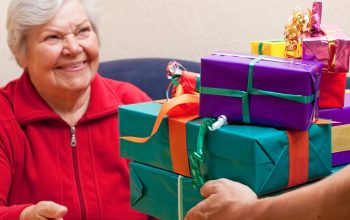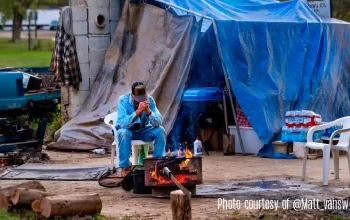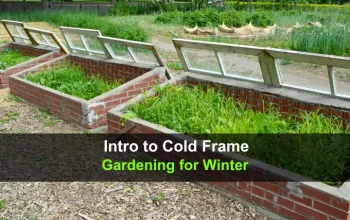Some of the links in this post may contain affiliate links for your convenience. As an Amazon associate I earn from qualifying purchases.
Guest post by Archie and Linda Dixon, authors of Just Dutch It!
Have you ever wondered how you would cook when there is no gas or electricity for an extended period?
Ice storms and tornadoes take out power lines for weeks. Earthquakes break natural gas and electrical lines. Hackers breach power grids and knock out power.
All of these scenarios have happened. And any of these emergencies could happen to us today.
So, how would you cook food?
Enter Dutch Oven cooking.
Why Knowing How to Cook in a Dutch Oven is a Valuable Skill
Think about it.
There’s not always sun to use your solar oven. The barbeque grill doesn’t bake bread very well, and that camp stove will run out of fuel if you have to use it for very long.
The Dutch oven, however, is a multi-tasking genius.
Long before refrigerators, gas stoves, ovens, microwaves, and instant pots, this versatile piece of cast iron cookware fed hardy folk. Cooks on cattle drives, pioneers crossing the plains, and even Lewis and Clark.
Breakfasts, lunches, dinners, desserts, and baked goods are all within your grasp. It passes the off-grid cooking test!
And what about fuel?
Wood and buffalo chips are okay, but modern-day charcoal briquettes are the best. And, briquettes are easy to store and not dangerous in any way. Plus, if they get wet, you just dry them out before using them.
What Kind of Dutch Oven Cooker Should You Buy?
You need a “camp” type Dutch oven. This isn’t the kind you see in cooking magazines, but the kind you take camping and use for outdoor cooking. It’s made out of cast iron (there are also aluminum ones), has a flat bottom, and three short legs.
The dutch oven cooker should have legs because these allow you to move briquettes in and out from under the oven, regulating the oven temperature. The lid has a raised rim around the edge so coals will stay on top while cooking, which is also important for proper cooking temperatures.
Using one without legs is totally doable, however. You just have to deal with creating a stable base; legs take care of a lot of that for you.
What size do I need?
Now some important questions: What size do I need? How many ovens should I have? This is something you need to think about.
A 12” oven is a good starting point. I also like a 14” and a 10”. With three ovens, you can cook your meals very quickly, although this could change depending on how many people you’re cooking for. This article will help you assemble and Dutch oven survival kit.
You may also want to look at how deep they are as well. Deep ovens are useful for things like soup.
Stack cooking is a great technique that maximizes your charcoal by stacking graduated sizes of ovens on top of each other. For example, you could stack a 14”, 12”, 10”, and a 5”. The charcoal on top of one oven becomes the briquettes underneath the base of the one stacked on top.
How do I care for it?
- Wash your new Dutch oven (or the one you might have picked up at a yard sale) in hot soapy water and scrub off the protective wax or oil the manufacturer put on unless instructed otherwise. To do this, use a stiff brush or green scrubbing pad. Dutch ovens are iron and will rust if not kept dry, even for a short time. This will be the only time you should need to use soap on your oven. Be sure to dry your oven quickly.
- Next, you need to “season” the oven. While still warm from washing, wipe the dry oven and lid with a lightly oiled paper towel or cotton cloth. Use regular vegetable oil. Don’t pour oil into the oven. Instead, pour the oil onto a cloth, then wipe. After oiling the Dutch oven, place it in your kitchen oven on the bottom rack at 350 degrees with the lid ajar. Bake for one hour. You may get strange-smelling fumes, so open a few windows. Repeat this process two more times. Now your Dutch oven is ready to use. You’ll notice it has turned a golden color, but it will have a black shine after continued use. This is what we want. If it does rust, just repeat the above process.
- After cooking in it, scrape out any remaining food with a spatula. When it has cooled slightly, put an inch or so of water in it and return it to the coals to boil and steam out the stuck food. After several minutes, remove it from the coals, and when it’s not too hot to handle, lightly scrub it with a brush or cleaning pad. Dry and lightly coat with oil, wiping off any excess.
- I always store my ovens with a small wad of aluminum foil under the rim of the lid. It’s also recommended to place a piece of paper towel or cotton cloth in the Dutch oven to absorb any moisture. If you don’t crack the lid with foil or something similar, I have found it very hard to get the cover off after it has been stored for a long time. Be sure to keep it in a dry place.
Warning: Do Not Put Cold Water In A Hot Dutch Oven. It Could Crack!
You will need several tools to begin cooking in your Dutch oven.
- Lid lifter and/or long-handled tongue and groove pliers
- Gloves
- 16” or longer tongs
- learn how to store charcoal.)
- Vegetable oil and applying clothes or paper towels
- Bricks for lid cooking
Also, when cooking in your Dutch oven, it must be on a flat surface clear of dried weeds, grass, etc. This is where a Dutch oven table is nice but not necessary. A 12” square concrete stepping stone is an inexpensive item to cook on. I recommend two, so you have one for the charcoal chimney.

How To Cook In A Dutch Oven
Once the briquettes are hot, what comes next?
You’ll need to place the hot coals (they are ready to use when they have white ash on part of them) evenly spaced around in a circle the size of the Dutch oven. Then, place the top coals evenly spaced on the lid. Use the tongs to do this.
Each recipe tells you how many briquettes to use. The basic rule is this. If it is a 10” oven, use 20 coals; use 24 coals for a 12? oven, etc. Just double the diameter of your oven, and that’s the number of coals you’ll need to cook with. This equals about 350 degrees.
For a cooler oven (like needed for granola), use less; for a hotter oven (like with rolls), use more.
When baking, you need twice as many coals on the top as on the bottom. This is because heat rises; therefore, more heat is needed on the top.
With your Dutch oven, you can fry, bake, boil, or use the lid as a griddle. Anything you cook in your kitchen oven or on the stovetop, you can cook with a Dutch oven!
Now how about some recipes so you can start Dutch oven-ing! (That’s a word, right?)
Recipes
I would like to share our story about how we created recipes using only food storage items. My husband Archie decided we needed to write a book about cooking food storage in Dutch ovens. We had cooked many different foods in Dutch ovens: biscuits and gravy, upside-down cakes, cobblers, chicken with rice, beef stew, rolls, and even Chicken Cordon Bleu.
But we didn’t have any recipes using just dried and canned food since that is what we had stored. In an emergency, the power could be out, and we wouldn’t be able to purchase food from the grocery store. There would probably be no fresh meats, no fresh vegetables or fruit, no fresh milk products, and no frozen microwave meals.
We were pretty good at Dutch oven cooking, but I had never used just food storage items to cook with, nor even thought of cooking food storage in Dutch ovens.
That’s when I got to work. I wanted to have recipes we were used to, so I got out some of my favorite recipes and modified them to use only food storage items.
Here are some very basic recipes to get you started. Some alternate ingredients are also listed to make them healthier or tastier. I hope you like them!
Chocolate Cake
- 10” or larger Dutch oven, 8 or 9 inch round or square pan; serves 9
- 24 – 26 briquettes; 10 on the bottom, 14- 16 on top; pre-heat 5 minutes; bake 30 minutes
Good:
1 ½ cups whole wheat flour
1 cup sugar
¼ cup unsweetened cocoa
1 tsp. baking soda
½ tsp. salt
1 Tbsp. vinegar (white or apple cider)
2 tsp. vanilla
1 cup water
1/3 cup oil
Directions:
Stir together the flour, sugar, cocoa, baking soda, and salt. Mix the vinegar, vanilla and water together and then add to the dry ingredients. Add the oil and mix well until smooth and creamy, about one minute. Grease and flour the pan, and pour the batter in the pan. Place pan on foil ring and cook for around 30 minutes. (check after 20 minutes). The cake is done when it has pulled away from the sides of the pan.
Better:
Use white flour in place of whole wheat.
Best:
Use melted butter in place of oil. Dust the top of the cooked cake with powdered sugar.
Banana Bread
- 12” or larger Dutch oven; 1 loaf
- 24 briquettes: 8 on the bottom, 16 on top; cook 1 hour
Good:
1 cup sugar
2 cups whole wheat flour
½ tsp. baking soda
1 tsp. cinnamon
½ tsp. salt
1 cup dried bananas, broken into tiny pieces, soaked until tender, and drained
½ cup oil
¼ cup reconstituted powdered milk
1 tsp. vanilla
Directions:
Lightly grease loaf pan. Mix dry ingredients (first 5). Cream together the remaining ingredients, then add wet ingredients to dry. Mix well. Pour batter into pan. Bake on a foil ring for 1 hour. Check for doneness. Cook until done (bread has pulled slightly away from sides). Do not add more briquets.
Better:
Replace whole wheat flour with white flour.
Best:
Replace oil with butter or butter-flavored shortening. Replace ½ of sugar with brown sugar. Add walnuts.
Note: You might say, “Banana Bread out of dried bananas?” Yes, this works really well. It’s better the next day, too, since the banana flavor has had time to permeate the whole loaf. Enjoy this one!
Chicken Noodle Soup
One of my favorites on a cold day is Chicken Noodle soup. Here is my version:
- 10” or larger Dutch oven; serves 6
- 20-25 briquettes, all on the bottom; cook 30 – 40 minutes
Good:
5 cups water
2 cups egg noodles
½ tsp. garlic powder
1 Tbsp. dried onion
3 chicken bouillon cubes
1-3 Tbsp. dried parsley
1 tsp. salt
¼ tsp. pepper
Directions:
Bring 5 cups of water to boil over all the briquets in your Dutch oven. Add all ingredients, making sure the chicken is broken up into pieces. When soup boils again, remove half of the coals and simmer for 12-15 minutes or until noodles are tender.
Better:
Add 1 tsp. celery powder or 1 Tbsp. dried celery
1 Tbsp. dried carrots
Best:
1 can chicken, liquid too
Note: This soup has lots of noodles. If you like broth, cut back on the noodles or add more water and bouillon. Enjoy this with a slice of whole-wheat bread.
Conclusion
Dutch oven cooking is a versatile off-grid cooking option that anyone can learn. It can function with several different fuel sources and can cook a wide variety of foods. I highly recommend adding cooking with a dutch oven to your emergency preparedness skillset.
What are your favorite foods to make in a dutch oven?
Originally published on January 12, 2011, and has been updated.
I’m the original Survival Mom and for more than 11 years, I’ve been helping moms worry less and enjoy their homes and families more with my commonsense prepping advice.



